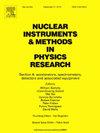Preparation of selenium target using sedimentation method for in-beam γ-ray spectroscopic measurement
IF 1.5
3区 物理与天体物理
Q3 INSTRUMENTS & INSTRUMENTATION
Nuclear Instruments & Methods in Physics Research Section A-accelerators Spectrometers Detectors and Associated Equipment
Pub Date : 2025-02-10
DOI:10.1016/j.nima.2025.170288
引用次数: 0
Abstract
Natural and isotopically enriched selenium targets with a typical thickness of 6.8 mg/cm were prepared using only 20 mg of powder, which was deposited on a Mylar backing through sedimentation process. The surface morphology of these targets was examined using scanning electron microscopy, while elemental analysis was conducted through -ray photoelectron spectroscopy, energy-dispersive -ray spectroscopy and -ray diffraction technique. These analyses confirmed that the selenium retained its crystalline structure, with no elemental impurities other than carbon and oxygen. The presence of carbon and oxygen was mainly due to the polyvinyl alcohol used during fabrication. The thickness of the targets was measured via -ray attenuation using a Germanium-based Low-Energy Photon Spectrometer. These targets were subsequently employed in ion-beam-induced -ray spectroscopic measurements to investigate the nuclear level structure of Br. Even after five days of continuous beam exposure, the condition of the targets remained unchanged. X-ray diffraction analysis of the irradiated targets showed no significant changes in microstrain and crystallite size.
求助全文
约1分钟内获得全文
求助全文
来源期刊
CiteScore
3.20
自引率
21.40%
发文量
787
审稿时长
1 months
期刊介绍:
Section A of Nuclear Instruments and Methods in Physics Research publishes papers on design, manufacturing and performance of scientific instruments with an emphasis on large scale facilities. This includes the development of particle accelerators, ion sources, beam transport systems and target arrangements as well as the use of secondary phenomena such as synchrotron radiation and free electron lasers. It also includes all types of instrumentation for the detection and spectrometry of radiations from high energy processes and nuclear decays, as well as instrumentation for experiments at nuclear reactors. Specialized electronics for nuclear and other types of spectrometry as well as computerization of measurements and control systems in this area also find their place in the A section.
Theoretical as well as experimental papers are accepted.

 求助内容:
求助内容: 应助结果提醒方式:
应助结果提醒方式:


